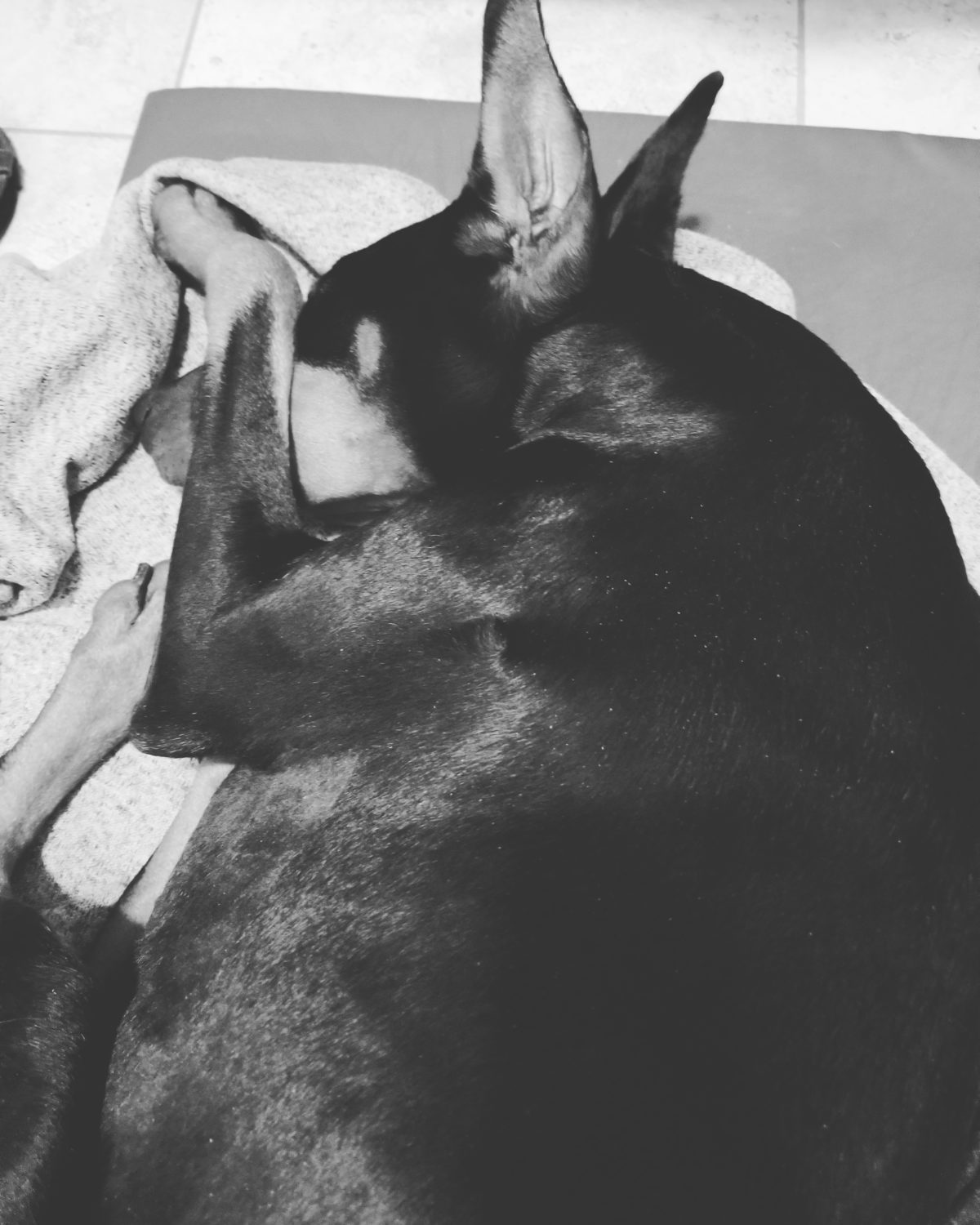
Young and active Doberman who’s usually on squirrel and chipmunk duty, soaked up her massage and even fell asleep for it.
It happens occasionally with the young, busy dogs during their massage or older dogs or really, any dog; they fall asleep or relax quietly during their massage. Bless their hearts. You see, it’s a big misconception that during a dog massage, dogs will act like humans… lay down, relax, stay still, fall asleep, sigh etc. Some do learn what’s happening and embrace it. Or occasionally really “get into it” from what us humans perceive. But what many dogs do during their massage is “be dogs”. They sniff the room, the dog bed, the chair, the blanket, the “this” the “that…they listen to what’s happening on the other side of the door, they seek out the treats, get a drink of water, anything and everything that dogs normally do when they enter a new space. During the dog massage they may try to figure out what I’m doing and how they should respond, they check in with their people. And just because they’re getting a massage doesn’t mean they will understand it. Some are nervous about being touched in certain areas, especially if they are painful or recovering from an injury. Some try to help in areas that they want more pressure by pushing and rolling or that feel particularly good being rubbed. The dog may even use their paw or nose to push my hand back to an area or away from one that hurts. But mostly, they may simply have a different agenda. And that’s okay.
Often, part way through the healing session, dogs need to get up and shake it off – it’s a normal neurological response to the stimulation and increase blood flow their body is getting from the massage techniques being performed on them. They may lick, chew, yawn and stretch; all normal release responses to the massage. Dogs may sit or lay quietly or they may be wiggly and active. Either way, we get the job done, addressing goals and help them feel more

Four month old Ella came in for her first massage. An active, sweet Chocolate Lab.
comfortable.
I’m equipped to work with the wiggles. I suggest clients bring a chew toy, frozen Kong or treats to keep them occupied. I have bully sticks for sale in the office, which, even for aggressive chewers, it will last the majority of the session. For those managing their weight, bringing their kibble meal and feeding it during the massage, one kernel at a time can do the trick to keep them stationary while helping them stick with their diet regimen. Also, the dogs that have learned commands such as “down”, and “stay” tend to do better at staying put upon request. In any case, I work with the dogs and their people to get the most out of their dog massage. I encourage them to remember that each dog has their own personality, agenda, attention span, boundaries and level of trust. It’s best to give them time to adjust and be prepared to assist with keeping their attention directed at being calm and still during the massage so I can focus on their healing. I have learned several tricks over the years too that I’ll initiate if needed. But sometimes, we all just have to be patient.
The dogs that are seen regularly will have a greater chance of learning how to behave to get the most out of their massage. I have dogs that are flopping onto their sides at my feet before I can get onto the floor with them, ones that will automatically flip half way between so I can get the other side and many dogs begin to participate more as they learn how I’m helping them. But this isn’t how every dog responds and even those that do, it’s not necessarily the way they respond for every massage.
The benefits and healing will be effective regardless if they participate and fully cooperate. So, here’s to honoring dog’s being dogs and working with them in the way they need each session.


Comments
Pingback: Dog Massage for Behavioral Issues - Animal Intuition
Pingback: Top 7 Ways to Prepare for Your Dog's Massage - Animal Intuition
Pingback: How Often Should My Dog Get Massaged? - Animal Intuition
Pingback: Top Signs Your Dog Is In Pain - Animal Intuition